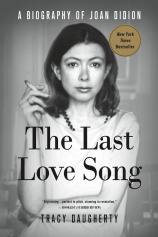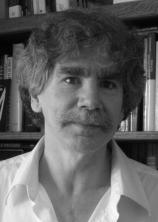The Last Love Song: A Biography of Joan Didion
Review
The Last Love Song: A Biography of Joan Didion
In some ways, a biography of Joan Didion seems beside the point. After all, this is a writer who once famously confessed that she and her husband, author John Gregory Dunne, were vacationing in Hawaii “in lieu of filing for divorce.” Her bestselling book, 2005’s THE YEAR OF MAGICAL THINKING, is an intimate account of her grief following Dunne’s death. After decades of exposing herself in print, what more could be said about a woman who once claimed that “The impulse to write things down is a peculiarly compulsive one, inexplicable to those who do not share it, useful only accidentally”?
Neither Didion nor her biographer, Tracy Daugherty, really believe that writing is of only accidental utility, of course. Yet the latter, who previously plumbed the lives of Joseph Heller and Donald Barthelme, is interested in Didion not just as a writer but as someone whose experiences tell us something about life in late-20th-century America: “In studying Didion, I am fashioning a literary biography as cultural history as well as an individual’s story…. Her life illuminates her era, and vice versa.”
Daugherty’s task is ambitious, especially since his subject declined to participate in the project, as did most of her still-living friends and family. He has attempted to overcome that obstacle through exhaustive research, ferreting out old interviews, digging through magazine archives, and immersing himself in Didion’s papers (on file at the University of California, Berkeley). He also tracked down the few acquaintances who are willing to be interviewed, and weaves in details from the writings of her husband and her brother-in-law, writer Dominick Dunne.
"...an engaging, if not always revelatory, portrait of Didion.... [A]s an account of recent American history as experienced by one of its most famous chroniclers, THE LAST LOVE SONG succeeds."
Considering the limitations of this approach, Daugherty has succeeded in crafting an engaging, if not always revelatory, portrait of Didion. While there aren’t any major “scoops,” his enthusiasm for his subject is never in doubt, as demonstrated by the way he mimics her signature style. In this passage, Daugherty sums up the political response to a massacre of hundreds of innocent civilians, which Didion covered in SALVADOR, a book that marked a hard turn toward the political in her writing:
“In spite of Susan Meiselas’s photographs of mass burials, charred skulls, and children’s decomposing bodies in the mud, in spite of detailed accounts of El Mozote by Raymond Bonner in The New York Times and Alma Guillermo-prieto in The Washington Post, the Reagan administration insisted there was no credible evidence of a massacre; no credible evidence that the Salvadoran Army’s Atlacatl Battalion, trained by U.S. Special Forces and armed with MI6s firing ammunition manufactured at Lake City, Missouri, had committed any such atrocity.
The facts on the ground disappeared. Didion wrote: ‘El Mozote entered the thin air of policy.’
Just change the script.
Trust me.”
The decision to tell Didion’s story in language similar to what she herself would use turns her into a kind of ghostly presence in the story of her own life. Daugherty’s tendency to draw biographical details from her well-known essays only adds to the sense of examining a fuzzy photocopy of the original. His account of her first visit to New York is the loosest paraphrase of “Goodbye to All That,” for example. Yet by interweaving this self-created mythology with details from her letters to friends and anecdotes from those who knew her, he does show how assiduously Didion worked to craft her distinctive literary persona.
Like his subject, Daugherty excels at noticing the small yet significant details, like Didion’s role in a high school production of Lillian Hellman’s “Watch on the Rhine.” In the play, a character asks, “What made Iago evil?” a line that will resurface nearly 20 years later in PLAY IT AS IT LAYS. He combs through back issues of Vogue and unearths unsigned pieces, likely by Didion. In these brief items, the author profiles campaign speechwriters and manages to work ominous references to the Donner Party into a piece about the Olympics in Squaw Valley, evidence that her ongoing interest in those subjects emerged early on.
THE LAST LOVE SONG never makes a strong case for why its subject is worthy of such a lengthy study; Daugherty’s strategy is to let the facts --- and Didion’s language --- do the heavy lifting. Mostly, this works; she’s already established herself as the sharp-eyed, cynical narrator of the past few decades of American experience, and the excerpts of her writing Daugherty includes justify that reputation. Yet bold assertions, such as labeling her novel DEMOCRACY “one of the finest achievements of twentieth-century American fiction,” don’t necessarily hold up under close scrutiny, and he does little in the way of exploring her influence on other writers.
It’s debatable whether Daugherty has managed to reveal “the bedrock beneath layers of myth, gossip, PR, self-promotion, [and] cultural politics” that surround Joan Didion. Ultimately, she remains something of a cipher --- the mix of steely reserve, biting intelligence and assorted neuroses that readers have known for decades. But as an account of recent American history as experienced by one of its most famous chroniclers, THE LAST LOVE SONG succeeds.
Reviewed by Megan Elliott on August 28, 2015
The Last Love Song: A Biography of Joan Didion
- Publication Date: October 4, 2016
- Genres: Biography, Nonfiction
- Paperback: 752 pages
- Publisher: St. Martin's Griffin
- ISBN-10: 1250105943
- ISBN-13: 9781250105943





